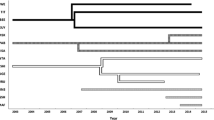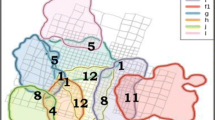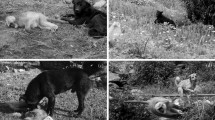Abstract
We investigated the effects of sex, age, season and competitive context on the intergroup agonistic behaviour of free-ranging dogs (Canis familiaris). Data were collected in different places to record competitive cooperative behaviour during intergroup conflicts. Observations of 21 free-ranging dogs belonging to four neighbouring groups were made in Katwa town, India. Throughout the 12-month study period, 85 % of all intergroup agonistic interactions recorded were aggressive and 15 % submissive. Intergroup aggressive interactions were more frequent during the late monsoon months when the females were in oestrus, while submissive interactions reached a peak during the winter months when the females were lactating. Adult dogs, particularly males, displayed a higher rate of aggressive behaviour than other age classes, whereas juvenile dogs, particularly males, displayed the highest rate of submissive behaviour. Male dogs were observed to perform more agonistic behaviours in mating contexts and at the boundaries of their territories, whereas female dogs displayed more agonistic behaviours in feeding contexts and in the vicinity of the den. Both aggressive and submissive patterns displayed by the dogs varied with the competitive contexts. The most frequently observed category of aggressive behaviour was ‘barking, growling and snarling’ and submissive behavioural patterns were displayed frequently by ‘lips retracted in a submissive grin’. The striking feature of this study was that in most cases, more than one dog participated in aggressive conflicts. Such cooperative defense predominantly occurred at the boundaries of territory. Group home range size was largest during the late monsoon months and during the winter months.




Similar content being viewed by others
References
Abrantes R (1997) Dog language. Wakan Tanka, Naperville
Altmann J (1974) Observational study of behaviour: sampling methods. Behaviour 49:227–267
Beck AM (1973) The ecology of stray dogs: a study of free-ranging urban animals. York Press, Baltimore, MD, p 98
Beck AM (1975) The ecology of feral and free-roving dogs in Baltimore. In: Fox MW (ed) The wild Canids: their systematics, behavioural ecology and evolution. Van Nostrand-Reinhold, New York, pp 380–390
Bekoff M (1979) Scent-marking by free-ranging domestic dogs. Biol Behav 4:123–139
Bekoff M, Wells MC (1986) Social ecology and behavior of coyotes. Adv Study Behav 16:251–338
Berman M, Dunbar I (1983) The social behaviour of suburban dogs. Appl Anim Ethol 10:5–17
Boitani L, Francisci F, Ciucci P, Andreoli G (1995) Population biology and ecology of feral dogs in Central Italy. In: Serpell J (ed) The domestic dog: its evolution, behaviour and interactions with people. Cambridge University Press, Cambridge, pp 217–244
Bonanni R, Valsecchi P, Natoli E (2010a) Pattern of individual participation and cheating in conflicts between groups of free-ranging dogs. Anim Behav 79:957–968
Bonanni R, Cafazzo S, Valsecchi P, Natoli E (2010b) Effect of affiliative and agonistic relationships on leadership behaviour in free-ranging dogs. Anim Behav 79:981–991
Bonanni R, Natoli E, Cafazzo S, Valsecchi P (2011) Free-ranging dogs assess the quantity of opponents in inter-group conflicts. Anim Cogn 14:103–115
Bradshaw JWS, Nott HMR (1995) Social and communication behavior of companion dogs. In: Serpell J (ed) The domestic dog: its evolution, behaviour and interactions with people. Cambridge University Press, Cambridge, pp 115–130
Burt WH (1943) Territoriality and home range concepts as applied to mammals. J Mammal 24:346–352
Cafazzo S (2007) Dinamiche sociali in un gruppo di cani domestici (Canis lupus familiaris) liberi in ambiente suburbano. PhD thesis, Univ. of Parma, Parma, Italy
Cafazzo S, Natoli E, Valsecchi P (2012) Scent-marking behaviour in a pack of free-ranging domestic dogs. Ethology 118:1–12
Carr GM (1985) Behavioural ecology of feral domestic dogs (Canis familiaris) in Central Italy. Proceedings of the XIX International Ethological Conference. Toulouse, France, Abstract 267
Chen SC, Tang FC, Lee HS, Yen CH, Lee MC (2000) An epidemiologic study of dog bites among postmen in central Taiwan. Chang Gung Med J 23:277–283
Daniels TJ (1983) The social organisation of free-ranging urban dogs. I. Non-estrous social behaviour. Appl Anim Ethol 10:341–363
Daniels TJ, Bekoff M (1989a) Population and social biology of free-ranging dogs, Canis familiaris. J Mammal 70:754–762
Daniels TJ, Bekoff M (1989b) Spatial and temporal resource use by feral and abandoned dogs. Ethology 81:300–312
Font E (1987) Spacing and social organization: urban stray dogs revisited. Appl Anim Behav Sci 17:319–328
Fox MW (1971) Behaviour of wolves, dogs and related Canids. Harper and Row, New York
Fox MW, Beck AM, Blackman E (1975) Behaviour and ecology of a small group of urban dogs (Canis familiaris). Appl Anim Ethol 1:119–137
Frank LG (1986) Social organization of the spotted hyena Crocuta crocuta; II, Dominant and reproduction. Anim Behav 34:1510–1527
Gese EM (2001) Territorial defense by coyotes (Canis latrans) in Yellowstone National Park, Wyoming: who, how, where, when, and why. Can J Zool 79:980–987
Ghosh B (1981) Some aspects of behavioural ecology of stray dogs (Canis familiaris) in urban and rural environments. PhD thesis, University of Burdwan, West Bengal, India
Gittleman JL, Thompson SD (1988) Energy allocation in mammalian reproduction. Am Zool 28:863–877
Hetts S (1999) Pet behavior protocols: what to say, what to do, when to refer. AAHA Press, Lakewood
Hsu Y, Sun L (2010) Factors associated with aggressive responses in pet dogs. Appl Anim Behav Sci 123:108–123
Kawanaka K (1973) Inter-group relations among Japanese monkeys. Primates 14:113–159
Kim YM, El-Aty AMA, Hwang SH, Lee JH, Lee SM (2009) Risk factors of relinquishment regarding canine behavior problems in South Korea. Tierarztl Wochenschr 122:1–7
Kirk RW (1977) Current veterinary therapy. Vol. VI., Small animal practice. Saunders, Philadelphia, p 1418
Kitchen DM, Cheney DL, Seyfarth RM (2004) Savannah baboons (Papio cynocephalus). Behaviour 141:197–218
Kitchen AM, Gese EM, Karki SM, Schauster ER (2005) Spatial ecology of swift fox social groups: from group formation to mate loss. J Mammal 86:547–554
Kleiman DG, Brady CA (1978) Coyote behavior in the context of recent canid research: problems and perspectives. In: Bekoff M (ed) Coyotes: biology, behavior and management. Academic, New York, pp 163–188
Kottferová J, Mareková J, Jakuba T, Ondrašovič M, Ondrašovičová O (2008) Aggressive behaviour of dogs and its ethological function. Folia Vet 52:73–74
Laundré JW, Keller BL (1984) Home range size of coyotes: a critical review. J Wildl Manag 48:127–139
Le Boeuf BJ (1967) Interindividual associations in dogs. Behaviour 29:268–295
Loudon ASI, Racey PA (1987) Reproductive energetics in mammals. Proceedings of a symposium held at the zoological society of London; 10–11 Apr 1986, Zoological Society of London, Clarendon Press: Oxford
Macdonald DW, Carr GM (1995) Variation in dog society: between resource dispersion and social flux. In: Serpell J (ed) The domestic dog: its evolution, behaviour and interactions with people. Cambridge University Press, Cambridge, pp 199–216
MacDonald DW, Ball FG, Hough NG (1980) The evaluation of home range size and configuration using radio tracking data. In: Amlaner CJ, MacDonald DW (eds) Handbook of biotelemetry and radio tracking. Pergamon Press, Oxford, pp 40–426
Manson J, Wrangham R (1991) Inter-group aggression in chimpanzees and humans. Curr Anthropol 32:369–390
Marijana V, Dordevic M, Brana RD, Ljiljana J, Mirilovic M (2008) Bites to humans caused by stray and owned dogs in belgrade. Acta Vet (Beograd) 58:563–571
Mech LD (1970) The wolf: the ecology and behaviour of an endangered species. Natural History Press, Doubleday
Mech LD (1993) Details of a confrontation between two wild wolves. Can J Zool 71:1900–1903
Milani MM (1986) The body language and emotion of dogs. Morrow, New York
Moran G, Fentress JC, Golani I (1981) A description of relational patterns of movement during ‘ritualized fighting’ in wolves. Anim Behav 29:1146–1165
Morgan M, Palmer J (2007) Dog bites. BMJ 334:413–417
O’Sullivan EN, Jones BR, O’Sullivan K, Hanlon AJ (2008) Characteristics of 234 dog bite incidents in Ireland during 2004 and 2005. Veterinary
Overall KL (1997) Clinical behavioral medicine for small animals. Mosby Year Book, St. Louis
Pal SK (2003) Urine marking by free-ranging dogs (Canis familiaris) in relation to sex, season, place and posture. Appl Anim Behav Sci 80:45–49
Pal SK (2005) Parental care in free-ranging dogs, Canis familiaris. Appl Anim Behav Sci 90:31–47
Pal SK (2008) Maturation and development of social behavior during early ontogeny in free ranging dog puppies in West Bengal, India. Appl Anim Behav Sci 111:95–107
Pal SK, Ghosh B, Roy S (1998a) Agonistic behaviour of free-ranging dogs (Canis familiaris) in relation to season, sex, age. Appl Anim Behav Sci 59:331–348
Pal SK, Ghosh B, Roy S (1998b) Dispersal behaviour of free-ranging dogs (Canis familiaris) in relation to age, sex, season and dispersal distance. Appl Anim Behav Sci 61:123–132
Pal SK, Ghosh B, Roy S (1999) Inter- and intra-sexual behaviour of free-ranging dogs (Canis familiaris). Appl Anim Behav Sci 62:267–278
Rubin HD, Beck AM (1982) Ecological behavior of free-ranging urban pet dogs. Appl Anim Ethol 8:161–168
Saunders G, White CL, Harris S, Rainier JMV (1993) Urban foxes (Vulpes vulpes): food acquisition, time and energy budgeting of a generalized predator. Symp Zool Soc Lond 65:215–234
Schenkel R (1967) Submission: its function in the wolf and dog. Am Zool 7:319–329
Scott JP (1950) The social behavior of dogs and wolves: as illustration of sociobiological systematics. Ann N Y Acad Sci 51:1009–1021
Scott JP, Fuller JL (1965) Genetics and the social behavior of the dog. The University of Chicago Press, Chicago
Seidler R, Gese E (2012) Territory fidelity, space use, and survival rates of wild coyotes following surgical sterilization. J Ethol 30:345–354
van Kerkhove (2004) An examination of the use of the ethological perspective for resolving inter-dog aggression problems. APDT Chron Dog 11:10–13
Voigt DR, Macdonald DW (1984) Variation in the spatial and social behavior of the red fox, Vulpes vulpes. Acta Zool Fenn 171:261–265
Wang HP, Tan CL, Gao YF, Li BG (2004) A takeover of resident male in the Sichuan snub-nosed monkey Rhinopithecus roxellana in Qinling Mountains. Acta Zool Sin 50:859–862
White PCL, Harris S (1994) Encounters between red foxes (Voles vulpes): implications for territory maintenance, social cohesion and dispersal. J Anim Ecol 63:315–327
Zhang P, Watanabe K, Li BG (2008) Dominance relationships among one-male units in a provisioned free-ranging band of the Sichuan snub-nosed monkeys (Rhinopithecus roxellana) in the Qinling Mountains, China. Am J Primatol 70:634–641
Zhao DP, Li BG, Grove CP, Watanabe K (2008) Impact of male takeover on intra-unit sexual interactions and subsequent interbirth interval of wild Rhinopithecus roxellana. Folia Primatol 79:93–102
Zhao DP, Chen Z, Baoguo LI, Romero T (2013) Sex-specific participation in inter-group conflicts within a multilevel society: the first evidence at the individual level. Integr Zool 8:441–454
Acknowledgments
I thank Dr Roberto Bonanni, Dr Simona Cafazzo and Prof. E. Font who read the drafts of this paper and improved its quality. I am sincerely grateful to the editor, associate editor and also to the anonymous referees for advice and comments on the earlier drafts of this paper. Special thanks to Dr. Subhadip Pal, Dept. of Statistics, University of Florida, Gainesville, Florida who helped with data analysis. Finally, thanks are due to Subhadip Pal (PhD student), Dip Narayan Dey (M.Sc.), Arindam Mondal (PhD) and Sohan Chatterjee (B.Sc.) who helped to collect data, and also to the local people who helped to locate the dogs.
Author information
Authors and Affiliations
Corresponding author
Rights and permissions
About this article
Cite this article
Pal, S.K. Factors influencing intergroup agonistic behaviour in free-ranging domestic dogs (Canis familiaris). acta ethol 18, 209–220 (2015). https://doi.org/10.1007/s10211-014-0208-2
Received:
Revised:
Accepted:
Published:
Issue Date:
DOI: https://doi.org/10.1007/s10211-014-0208-2




